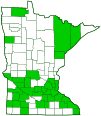hound’s tongue
(Cynoglossum officinale)
Conservation • Weed • Wetland • Description • Habitat • Ecology • Use • Distribution • Taxonomy
Description |
||
Hound’s tongue is a 8″ to 48″ tall, erect, biennial forb rising from a thick, black, branching taproot. In the first year it forms a rosette of basal leaves on long leaf stalks. The leaves are dark green, 4″ to 12″ long, ⅞″ to 2″ wide, elliptical, and covered with short, soft hairs. A single root system can produce 1 or several rosettes. In the second year the plant sends up a single 8″ to 48″ tall flower stem from the center of the rosette. The stem branches in the upper half. There are leaves from the bottom to the top of the stem. The stem leaves are alternate and untoothed. The leaves are on leaf stalks, which become progressively shorter as they ascend the stem. The upper leaves are attached to the stem without leaf stalks, and may clasp the stem. The leaves become progressively smaller as they ascend the stem. The upper and lower surfaces are covered with short, soft hairs. The inflorescence is many raceme-like, crowded clusters rising from the upper leaf axils or on short branches at the top of the stem. The clusters may have as many as 35 flowers, but they usually have no more than 10. The flowers are ¼″ to ⅓″ wide and have 5 maroon or red petals. The petals are fused at the base into a short, funnel-shaped tube. The tips are rounded and overlapping. The fruit consists of 4 nutlets, each ⅓″ long, covered with short, barbed prickles. |
||
Height |
||
8″ to 48″ |
||
Flower Color |
||
Maroon to red |
||
Similar Species |
||
Northern wild comfrey (Cynoglossum virginianum var. boreale) has stem leaves only on the lower half of the stem. The inflorescence is 1 to 4 (usually 3) racemes branching at the end of a stalk that terminates the central stem. The flowers are light blue. |
||
Habitat |
||
Dry. Woods, disturbed sites. |
||
Ecology |
||
Flowering |
||
June to July |
||
Pests and Diseases |
||
|
||
Use |
||
|
||
Distribution |
||||
|
Sources |
|||
| 5/1/2023 | ||||
Nativity |
||||
Native to Europe and Asia. Introduced and naturalized in North America. |
||||
Occurrence |
||||
|
||||
Taxonomy |
|||
| Kingdom | Plantae (Plants) | ||
| Subkingdom | Pteridobiotina | ||
| Phylum | Tracheophyta (Vascular Plants) | ||
| Class | Magnoliopsida (Dicots) | ||
Order |
Boraginales (borages) | ||
Family |
Boraginaceae (borage) | ||
| Subfamily | Cynoglossoideae | ||
| Tribe | Cynoglosseae | ||
Genus |
Cynoglossum (hound’s tongues) | ||
Subordinate Taxa |
|||
|
|||
Synonyms |
|||
|
|||
Common Names |
|||
common houndstongue gypsy-flower gypsyflower hound’s tongue houndstongue hound’s-tongue rats-and-mice |
|||
Glossary
Axil
The upper angle where the leaf stalk meets the stem.
Bract
Modified leaf at the base of a flower stalk, flower cluster, or inflorescence.
Clasping
Describing a leaf that wholly or partly surrounds the stem but does not fuse at the base.
Oblong
Two to four times longer than wide with nearly parallel sides.
Raceme
An unbranched, elongated inflorescence with stalked flowers. The flowers mature from the bottom up.
Visitor Photos |
|||||
Share your photo of this plant. |
|||||
| This button not working for you? Simply email us at info@MinnesotaSeasons.com. Attach one or more photos and, if you like, a caption. |
|||||
|
|||||
MinnesotaSeasons.com Photos |
|||||
Plant |
|||||
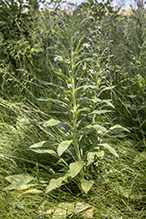 |
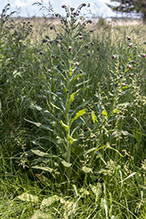 |
||||
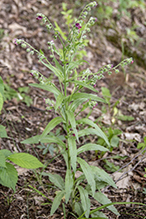 |
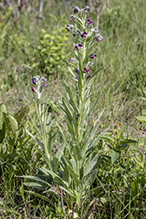 |
||||
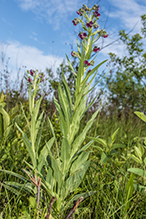 |
 |
||||
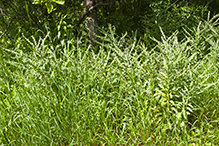 |
|||||
Inflorescence |
|||||
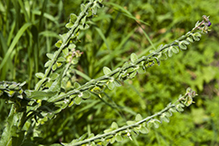 |
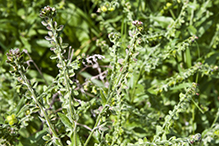 |
||||
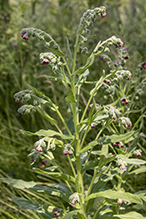 |
 |
||||
Flowers |
|||||
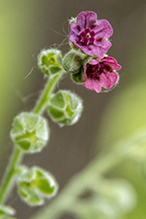 |
 |
||||
 |
|||||
Basal Leaves |
|||||
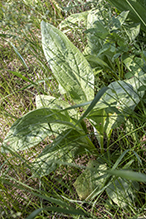 |
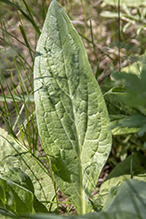 |
||||
Infructescence |
|||||
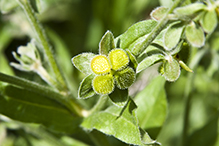 |
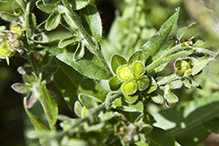 |
||||

Slideshows |
||
| Cynoglossum officinale Aina WestCoast |
||
About
Published on May 11, 2013 · Plants of future (http://www.pfaf.org/user/Plant.aspx?LatinName=Cynoglossum+officinale) · GRIN - Taxonomic information (http://www.ars-grin.gov/cgi-bin/npgs/html/genus.pl?3284) |
||

Visitor Videos |
|||
Share your video of this plant. |
|||
| This button not working for you? Simply email us at info@MinnesotaSeasons.com. Attach a video, a YouTube link, or a cloud storage link. |
|||
Other Videos |
|||
| Hounds' Tongue Cynoglossum officinale Craig D. |
|||
About
Uploaded on May 5, 2010 Alternate leaves forming a rosette 1st. year sending up a flowering stalk in the 2nd year. The prickly fruits are ovate and flat looking like little hound's tongues(supposedly) that stick to anything especially your socks! Regarded as a noxious weed although closely related to comfrey and been used interchangebly so. Houndstongue is used in the medical industry as an analgesic. |
|||
| Houndstongue (Cynoglossum Officinale) / Gypsy Flower - 2012-05-30 W3stlander |
|||
About
Published on May 31, 2012 Cynoglossum officinale (houndstongue, houndstooth,dog's tongue, gypsy flower, and rats and mice due to its smell) is a herbaceous plant of the family Boraginaceae --------------- |
|||
| Environmental Laboratory - U.S. Army Corps of Engineers Environmental Laboratory USACE |
|||
About
Published on Feb 15, 2013 Cynoglossum officinale - Houndstongue |
|||

Visitor Sightings |
|||||
Report a sighting of this plant. |
|||||
| This button not working for you? Simply email us at info@MinnesotaSeasons.com. Be sure to include a location. |
|||||
|
|||||
MinnesotaSeasons.com Sightings |
|||||

|
Created: Last Updated: © MinnesotaSeasons.com. All rights reserved. |
